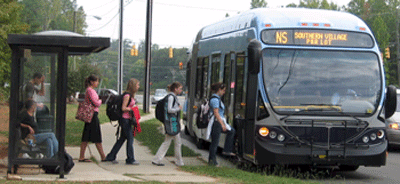{Cross Posted from Chapel Hill News}

If you boarded a Chapel Hill Transit bus back in February, you might have been greeted by someone with a clipboard asking you to answer a few questions about your ride. The results of this survey were just released and include relevant and interesting findings as we think about the future of transit in our community.
These survey data tell us quite a bit about who rides Chapel Hill Transit. Most riders (88 percent) were somehow affiliated with UNC, and 93 percent of those surveyed were taking the bus to get to college or work. A majority (68 percent) ride the bus five days a week while another 21 percent use it three or four days a week.
The survey also tells us what would encourage riders to use Chapel Hill Transit more often. Riders said more frequent service (49 percent), later evening service (43 percent), and more Saturday (39 percent) and Sunday (36 percent) service would get them on the bus more often. These findings are consistent with the last Chapel Hill Transit survey findings from 2012.
More data are available in the full survey results, but the findings about who rides transit in our community and what would encourage them to ride more frequently stand out to us as guideposts for thinking about the future of transit. Chapel Hill Transit – and its success in growing into the second largest transit system in North Carolina, behind only Charlotte – is one of the key reasons our community is poised to become a leading 21st-century community in our state.
Since going fare-free in 2002, Chapel Hill Transit ridership more than doubled in just 10 years and stands at over 7 million rides per year now. This dramatic increase in transit usage has made our community a more environmentally sustainable place and reduced traffic congestion in areas with frequent, reliable transit service. The fare-free service model has also received national attention for its innovative approach and success in expanding transit usage.
We can see from these new survey data that Chapel Hill Transit needs more money and resources to continue to add transit service and expand service hours into the night and weekend hours. While revenue from our transit tax has funded route expansions and service increases since 2013, these data also show that as we seek to diversify our economy, special attention should be devoted to getting non-UNC affiliated residents and workers out of their cars and onto the bus as well.
The good news is that these findings support what we already should be doing. Transit is in demand nationally, and the more we can do to foster transit use, the stronger position our community will be in as we compete for new jobs and new residents. A new HNTB survey, for example, found that more than half of Americans (55 percent) are willing to pay more to live closer to public transportation. Among millennials, 70 percent are willing to pay more to free themselves from automobile dependence.
It takes more than just transit investment to position our community for future success. It also takes changes to how we grow and develop in order to make strong transit use viable and to be a desirable place to live in the 21st century. That means our community needs to become more densely developed, with more walkable places and spaces, more housing to fit all types of lifestyles (and to improve housing affordability), and new commercial, retail, and office space with easy access to transit to eliminate the need to drive to work.
There’s plenty of support to change how we develop, too. Nationally, 73 percent of Americans want changes to land-use regulations to support transit-oriented development. Put another way, nearly three-fourths of Americans want taller buildings, more apartments, condos, and other innovative housing choices, shopping and offices near their homes (or even in the same building), less parking taking up valuable space, and more frequent, reliable transit service to help them get around. Given that Chapel Hill is less dense than many of our college town peers like Charlottesville, Ann Arbor, Burlington, Boulder, Bloomington, and Madison, we have plenty of room to add density to move us closer toward our goals.
Chapel Hill Transit is already a fantastic asset to our community, and current transit planning efforts for expansion, like the North-South Corridor Bus Rapid Transit Study, continue to position our community for transit success. But it will take more resources, better land-use planning, and a willingness to welcome new neighbors, new housing choices, and new private-sector jobs for us to achieve real success in the future.
Travis Crayton (tjcrayton@gmail.com) and Molly De Marco (mollydemarco@gmail.com) are editors of the blog OrangePolitics.org and live in Chapel Hill.


